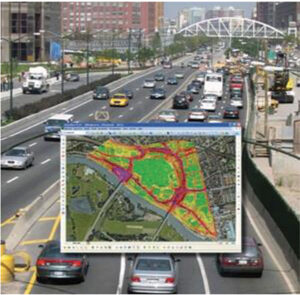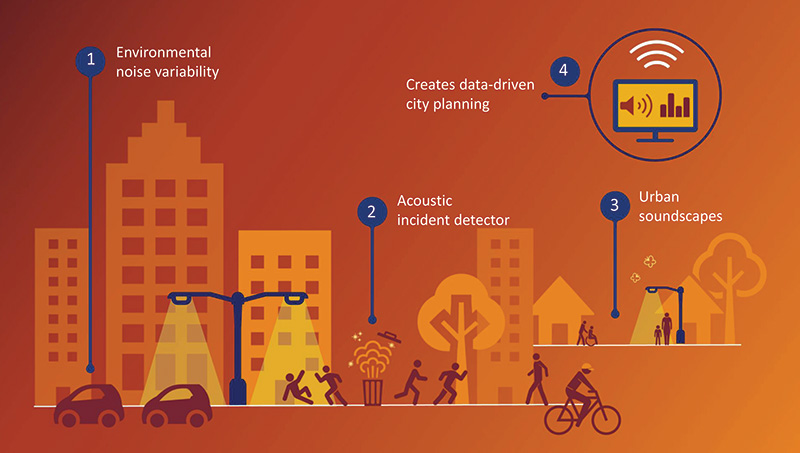By incorporating noise-monitoring sensors on light poles, Los Angeles explores another application for connected street lighting
By Susanne Seitinger
City lights are dazzling, but they’re more than ubiquitous fixtures illuminating the public spaces where people live, work, shop, dine and interact; they are potential touchpoints with a significant role in our increasingly digital world. Innovative LED lighting is helping to generate safer, more livable and more responsive environments, in which the public infrastructure is as connected as we are. Globally, just 2 percent of installed street lighting systems are connected, but this number is set to reach 35 percent by 2025, according to a recent market analysis from Philips. Connected lighting empowers cities to transform every light into a smart hub, each pole capable of collecting a range of data points about the city, thereby providing value beyond basic illumination. The potential applications of connected street lighting are varied and expansive. The data collected, for example, can help monitor the parking availability on city streets; measure airborne pollution and the impact of weather on city streets; track energy use; and, of course, report streetlight and other more advanced data for operations.
 One less studied connected street lighting application is the use of sensing capabilities to monitor sound levels, which consist of various statistics such as maximum and minimum levels within certain frequency bands or averages aggregated over particular time periods. They encompass a 24-hour cycle, not just the operational phase of the street lighting at night. Acoustic monitoring around environmental noise variability can be used for enforcing noise pollution guidelines, detecting incidents or developing detailed models of urban soundscapes that will inform city leaders’ longer-term decision making.
One less studied connected street lighting application is the use of sensing capabilities to monitor sound levels, which consist of various statistics such as maximum and minimum levels within certain frequency bands or averages aggregated over particular time periods. They encompass a 24-hour cycle, not just the operational phase of the street lighting at night. Acoustic monitoring around environmental noise variability can be used for enforcing noise pollution guidelines, detecting incidents or developing detailed models of urban soundscapes that will inform city leaders’ longer-term decision making.

Environmental noise monitoring provides continuous, dense data on urban noise, enabling planners to underpin citywide development decisions like traffic planning or school placement. “Loudness,” for example, varies substantially by street, as well as by time of day, especially around rush-hour peaks. This type of data can inform and monitor public health initiatives related to environmental conditions. In addition, urban soundscape monitoring can take these insights to the next level by measuring sound levels and tracking compliance with regulatory limits. Unlike most traditional compliance monitoring focused only on particular thresholds, more advanced metrics might include specific high or low frequency bands. With new insights, cities are accordingly able to handle noise nuisance complaints from neighborhoods, housing associations and environmental health officers. Finally, noise maps also help inform urban planning for the long term, with advanced-use cases looking at more in-depth analytics to extract specific activity information on that place.
L.A. STORY
The City of Los Angeles has a vision for how technology can adapt to the way people and communities interact with their surroundings. The city’s lighting infrastructure is among the largest in the world and one of its most valued assets. Moreover, the ubiquity and scale of the existing infrastructure provides a foundation to realize the potential of connected lighting. Today, Los Angeles is pioneering how existing connected street lighting infrastructure can become a catalyst for deploying innovative technology and Internet of Things (IoT) functionality across its more than 215,000 streetlights.
SMART CITY SPRAWL
As seen through the Los Angeles example, existing infrastructure such as street lighting can be an important pathway for leveraging the Internet of Things to address the needs of cities and citizens. Street lighting, in its pervasive, uniform structure, acts as the backbone of a smarter city—a place to connect devices and acquire additional information about what is occurring so broad groups of city stakeholders, from those maintaining physical infrastructure to those delivering emergency services, are responsive and able to access services tailored to specific needs. Collaborations with forward-thinking cities such as Los Angeles will help advance the true mission of smart cities: creating healthier lives and making people feel safe and comfortable. And technology is a fundamental instrument to achieving those outcomes. |
The Los Angeles Bureau of Street Lighting began rolling out CityTouch last year: a connected street lighting management system that uses mobile networks and cloud-based technologies to control streetlights, monitor status and accurately analyze how much energy each light is consuming. The system enables the city to directly link operational activities in the field with its back-office asset management work. Building on this rollout, the pilot project with Los Angeles helps optimize lighting infrastructure investments with the addition of enhanced smart city capabilities, including acoustic sensing and noise monitoring specifically designed to improve public services, safety and livability for residents, visitors and local businesses.
Los Angeles is amplifying environmental noise monitoring with new connected, noise-sensing microphone modules mounted to a portion of Philips CityTouch enabled light poles. From sensors mounted on the street poles to software that acquires, analyzes and shares the data, the pilot is yielding fine-grained insights on the dynamic rhythms of the city that will inform more transparent city operations. This data creates a better understanding of how the design of the city and daily uses impact the street-level environment.
City managers and planners can monitor the aggregated data via a cloud-based dashboard with a continuously updated visualization. This active monitoring can help reduce noise pollution by ensuring faster response times to noise complaints, and—in the long run—improve urban planning decisions. The study found strong cyclical daily patterns reflecting the mix of uses in the neighborhood from residential to some light industrial. Specific incidents such as trucks idling on a residential street or the impact of vegetation to lower noise levels could be clearly identified.
Another key example of how the citizens of Los Angeles can benefit from acoustic sensing and environmental noise monitoring in the future is the use of these technologies to reduce emergency response time and support earlier patient intervention. Thanks to abundant streetlights on roads, highways, tunnels and walkways, acoustic sensing can detect the sound of a motor vehicle collision. As soon as something is logged, the system can provide timely information directly to the city’s communications dispatch system for police, fire and EMS.
Through the CityTouch pilot project, Los Angeles is going beyond acoustic monitoring. The light poles also procure power quality parameters (voltage and frequency) continuously—and at an unprecedented scale—helping the public lighting department monitor the health of its lighting network. This data will help to quickly inform grid managers of outages, and as a result, residents and local businesses will benefit from faster restoration of power. Over time, the Bureau of Street Lighting will also benefit from more detailed luminaire health data, increasing maintenance planning effectiveness and cost savings—and in conjunction with grid health data—leading to the creation of advanced maintenance models.

